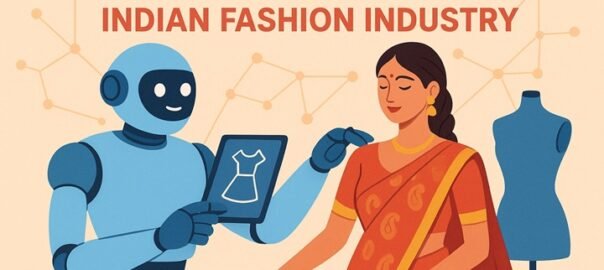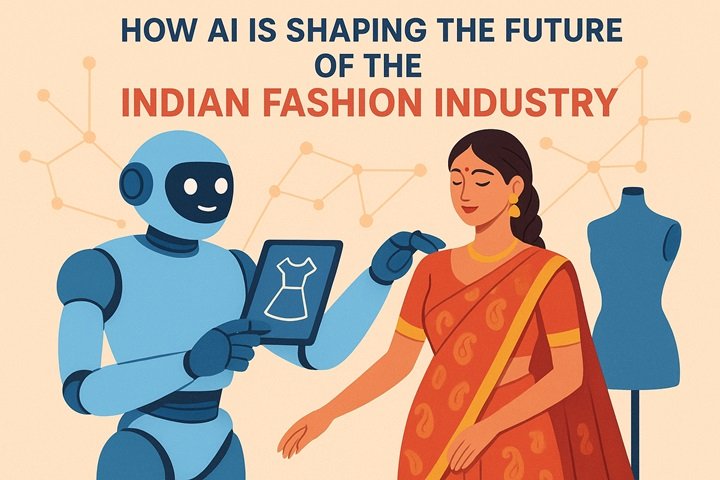
Smart Fashion: How AI Is Shaping the Future of the Indian Fashion Industry
The Indian Fashion industry is a thriving sector, defined by rapid growth and global recognition. The fashion industry is thriving because it is being fueled by rising disposable incomes, increase in internet penetration, influence of global fashion trends, rise in online shopping and a growing younger population who are adopting new technologies and channels.
In the Indian fashion industry, the e-commerce market is growing at rapid pace and is ahead of the traditional retail sector. It is on track to become the dominant force for fashion sales in the coming years.
The dominance of the e-commerce sector in the Indian fashion industry can be attributed to its convenience, wide range of selection, easy accessibility, and competitive pricing. In contrast, physical retail stores are limited by location, limited shelf space, and high operational costs.
As reported by COHERENT MI, the Indian fashion e-commerce market size was valued at US$21.60 billion in 2025, and is projected to reach US$98.45 billion by 2032, growing at a CAGR of 24.2% from 2025 to 2032.
The leading e-commerce brand in the fashion sector is Myntra.
The Indian fashion retail sector is growing, and is being fuelled by rising disposable incomes, urbanization, changing consumer preferences, and a growing focus on fast fashion.
A report by IMARC revealed that the Indian fashion retail market size reached USD 3.19 billion in 2024, and the IMARC group expects the market to reach USD 5.78 billion by 2033, exhibiting a CAGR of 6.82% during 2025-2033.
The leading retail brand in the fashion industry is Reliance Retail.
With the growth of the Indian fashion industry, especially in the ecommerce sector, brands are resorting to the use of artificial intelligence (AI) to enhance customer experience, optimise operations to stay one step ahead in a competitive market.
Artificial Intelligence has elevated the fashion industry to a more advanced level. It has become a global sensation, making a world of difference to professionals in the fashion industry. A report by Mordor Intelligence predicts that the global AI in the fashion market will grow from USD 270.4 million in 2020 to USD 1,260.9 million by 2026 with a CAGR of 29.0%.
Artificial Intelligence in the Indian fashion industry has offered numerous possibilities to industry professionals as well as consumers, in the form of personalised recommendations, chat bot services, virtual try-ons, customization, product recommendations, forecasting trends, and much more.
Let’s take a look at how AI is revolutionising the fashion industry.
- Personalised Customer Experience- This is the most significant change artificial intelligence has brought about in the fashion industry. Artificial intelligence has simplified and made the shopping experience seamless for customers. How artificial intelligence has made this possible is through:
- AI- Powered Product Recommendations- E-commerce platforms like Myntra, Flipkart, Amazon use Artificial Intelligence algorithms to analyse the customer browsing patterns, user preferences and purchase history. Using this data, the companies offer tailored suggestions to make the shopping experience a memorable one. On the flip side, the data helps sellers understand what the customer is looking for and in return increases the chance for a purchase which elevates the brand.
- Virtual Try Ons- In the online segment, a major setback has been not being able to know the size, fitting and how it looks when worn. To make this process easier, augmented reality [AR] and virtual reality [VR] came into the picture. AI powered fitting rooms have made virtual try-ons a reality. Virtual reality assists in creating a 3D model which takes into account the customer size, body type, height and weight. This lets the customer see how the outfit looks on them, before they make the purchase. It helps them make a correct choice.
- Customization- Artificial Intelligence makes it easier than ever for people to personalize the products they buy. With AI-powered tools, customers can tweak things like color, fabric, size, pattern, or even add their own text or images to a product. Many websites now offer real-time previews or virtual models, so you can actually see what your custom item will look like before you order it. A great example is Nike’s “Nike By You,” where you can design your own sneakers by picking different styles and colors.
- Trend Forecasting– AI scans through data from social media, previous sales data, fashion blogs, trending fashion choices. This data that is collected helps AI algorithms to understand and analyse customer taste, and purchase patterns to help forecast upcoming styles.
- Analysis of Consumer Behaviour- Artificial Intelligence analyses a consumer’s browsing history, search trends, and, purchase behaviour on e-commerce platforms. By identifying which products are in high demand, AI can forecast which items and styles will be in trend in the coming seasons. This approach helps brands tailor their products and to stock the right products.
- Sustainable Fashion- As environmental awareness grows, more consumers are turning to sustainable fashion, and AI is playing a vital role in supporting this shift. Tools like patented AI help designers generate unique clothing patterns that optimize fabric use, minimizing waste during the cutting and design process. AI also enhances production efficiency by accurately predicting demand based on sales data and customer behaviour, helping brands avoid overproduction. Additionally, AI recommends sustainable materials such as organic cotton, recycled polyester, and bamboo, while also suggesting eco-friendly manufacturing practices to reduce environmental impact. With advanced algorithms, AI identifies opportunities to cut energy consumption without compromising quality. Smart automation further ensures precision, reduces errors, and minimizes overall waste, making fashion production more sustainable.
- Chatbots- AI powered chatbots or virtual assistants are available 24/7. They respond to queries in a swift manner and support in multiple regional languages. They deliver accurate product information, address key customer concerns, assist the shopping journey and streamline the shopping purchase. They also offer personalised recommendations tailored to customer preferences.
- Product Design and Innovation
- AI Driven design concepts- Artificial Intelligence evaluates the target market, understands the customers taste and preferences, and, the style that is in demand. AI Tools like DALL E, Deepart help designers visualise new fabrics, patterns, designs, and much more by creating a visual prototype. This then allows the designer to create a unique pattern by blending in their imagination and the automated result to create a totally unique design.
- 3D Prototyping- software like CLO 3D and Browzwear which is powered by AI allows designers to create digital garment prototypes and evaluate their appeal and market demand. This minimizes the need for physical samples, conserving both time and resources. Designers can also visualize how different fabrics will appear and behave on a model, enhancing accuracy in the final product. By using 3D prototyping, the risk of errors is significantly reduced, and it becomes easier to produce fashion items that resonate with consumers. In essence, AI-driven software streamlines the entire design-to-production process while maintaining high quality.
- Influencer partnerships- AI platforms analyze engagement data and audience demographics to pinpoint the most relevant and impactful influencers in the fashion industry. This enables brands to connect with influencers who are more likely to resonate with their target audience and drive product sales. Additionally, AI tools monitor campaign performance by tracking post analytics, allowing brands to assess the effectiveness of influencer collaborations and make informed decisions about future partnerships.
In conclusion, artificial intelligence is transforming the Indian fashion industry by enhancing efficiency, creativity, and customer satisfaction. From personalized shopping experiences and virtual try-ons to trend forecasting, sustainable production, and innovative design tools, AI empowers brands to stay competitive in a competitive market. It also streamlines operations through automation, improves product-market fit with demand prediction, and strengthens marketing strategies through data-driven influencer partnerships. As the fashion sector, especially e-commerce continues to grow, AI is set to play a bigger and more important role in shaping the future of fashion, not just in India, but around the world. It’s helping the industry become smarter, more sustainable, and more focused on what customers really want.






